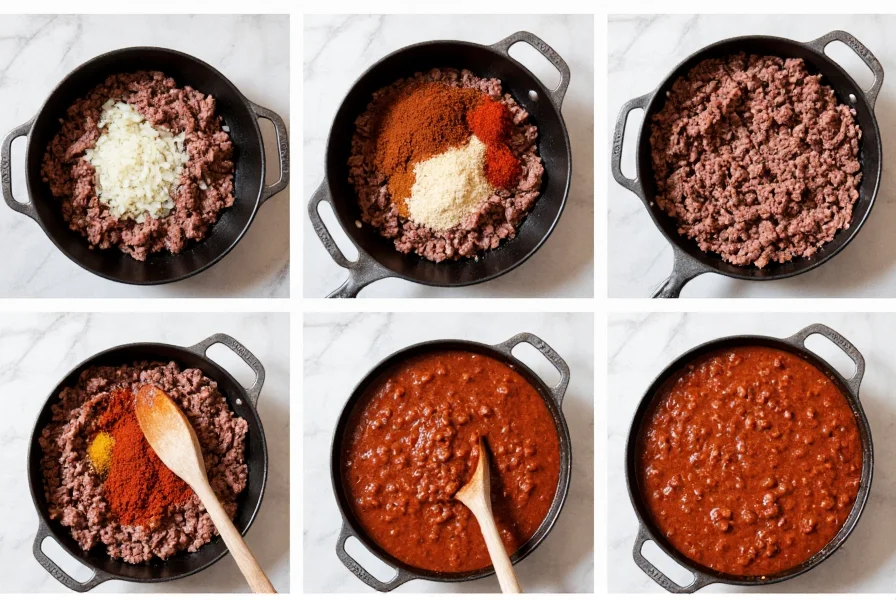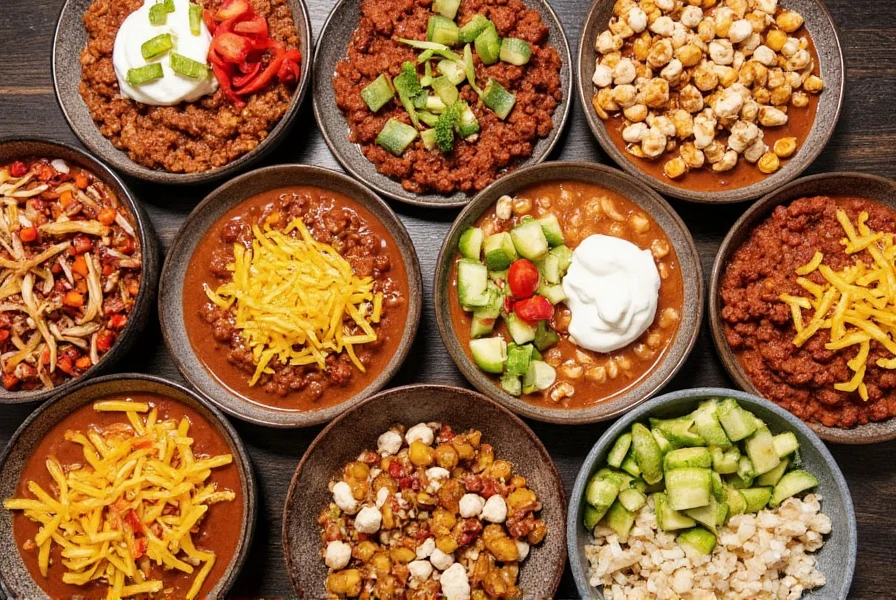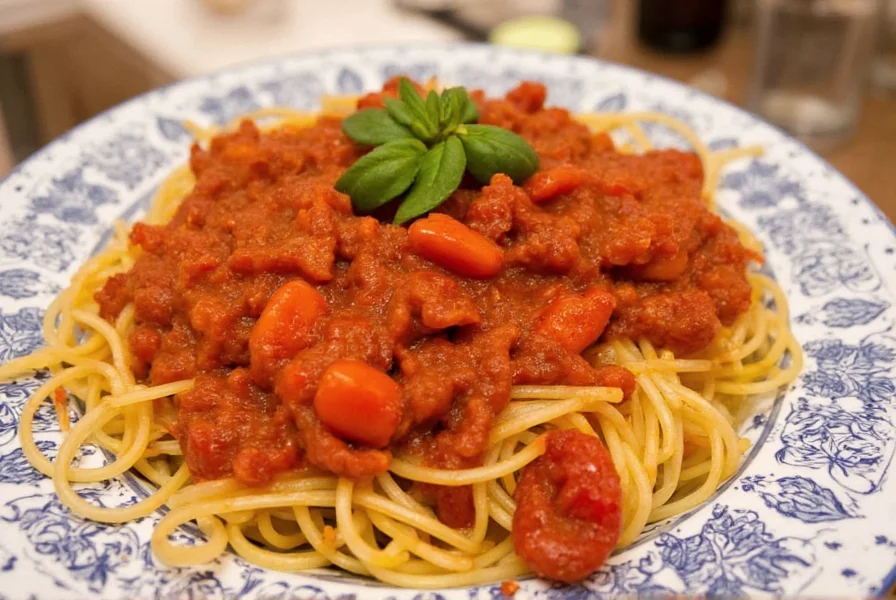Chili is one of America's most beloved comfort foods, with regional variations spanning from Texas-style meat chili to Cincinnati-style with spaghetti. A well-crafted chili recipe balances rich meaty flavors, aromatic spices, and the perfect texture that develops through proper simmering. Whether you're preparing for game day, a family dinner, or meal prepping for the week, mastering this versatile dish is essential for any home cook.
Why This Homemade Chili Recipe Works
This chili recipe stands out because it emphasizes layering flavors at each step rather than just dumping ingredients together. The secret to exceptional chili lies in the Maillard reaction when browning the meat properly, the careful balance of spices toasted to release their essential oils, and the crucial simmering time that allows flavors to meld. Unlike many quick chili recipes that compromise on depth of flavor, this method produces restaurant-quality results with ingredients you likely already have in your pantry.
Essential Ingredients for Authentic Chili
The foundation of great chili starts with quality ingredients. Here's what you'll need for the classic version, with notes on substitutions where appropriate:
| Ingredient | Amount | Preparation Notes |
|---|---|---|
| Ground beef (80/20) | 1 lb | Provides ideal fat content for flavor; can substitute ground turkey for leaner option |
| Yellow onion, diced | 1 medium | Yellow onions provide the best balance of sweetness and pungency |
| Garlic cloves, minced | 3 | Fresh garlic essential; avoid pre-minced for best flavor |
| Green bell pepper, diced | 1 | Adds subtle sweetness; red or yellow peppers work too |
| Crushed tomatoes | 1 (28-oz) can | San Marzano preferred for richer flavor |
| Red kidney beans, drained | 1 (15-oz) can | Can substitute pinto beans for traditional Texas-style |
| Chili powder | 2 tbsp | Use pure chili powder, not chili seasoning mix |
| Ground cumin | 1 tsp | Toasting whole cumin seeds then grinding yields best flavor |
| Smoked paprika | 1 tsp | Adds depth; regular paprika works but lacks smokiness |
| Beef broth or water | 1 cup | Broth enhances meaty flavor; low-sodium preferred |

Step-by-Step Cooking Instructions
- Brown the meat: Heat a large pot or Dutch oven over medium-high heat. Add ground beef, breaking into small pieces. Cook until well-browned (not just grayed), about 8-10 minutes. Proper browning creates fond (those browned bits) that adds tremendous flavor. Drain excess fat if desired, but leave about 1 tablespoon for cooking vegetables.
- Saute vegetables: Add diced onion, bell pepper, and a pinch of salt to the pot. Cook until softened, about 5-7 minutes. Add minced garlic and cook for 1 minute until fragrant.
- Bloom spices: Stir in chili powder, cumin, smoked paprika, and black pepper. Cook for 1-2 minutes, stirring constantly, to toast the spices and release their essential oils.
- Combine ingredients: Add crushed tomatoes, kidney beans, and beef broth. Stir well to combine, scraping the bottom of the pot to incorporate all the flavorful browned bits.
- Simmer: Reduce heat to low, cover partially, and simmer for 45-60 minutes, stirring occasionally. The longer it simmers (up to 2 hours), the more the flavors will meld. If chili becomes too thick, add additional broth or water.
- Season and serve: Taste and adjust seasoning with salt and additional spices as needed. For deeper flavor, refrigerate overnight and reheat before serving.
Cooking Time Breakdown
- Prep time: 20 minutes
- Cook time: 45-60 minutes (minimum), up to 2 hours for maximum flavor development
- Total time: 65-80 minutes
- Servings: 6
Serving Suggestions for Your Homemade Chili
Traditional chili toppings enhance both flavor and texture. Serve your chili hot with a selection of these classic accompaniments:
- Freshly grated sharp cheddar cheese
- Sour cream or Greek yogurt
- Thinly sliced green onions
- Chopped fresh cilantro
- Lime wedges for a bright citrus note
- Sliced jalapeños for extra heat
- Cornbread or saltine crackers on the side
For a heartier meal, serve over cooked rice, with a side of cornbread, or as a topping for baked potatoes. Cincinnati-style chili traditionally serves over spaghetti with cheese.
Storage and Reheating Instructions
Chili actually improves in flavor after sitting, making it perfect for meal prep:
- Refrigeration: Store in an airtight container for up to 4 days
- Freezing: Freeze in portion-sized containers for up to 3 months
- Reheating: Warm on stove over medium-low heat, stirring occasionally and adding a splash of broth or water if needed. Microwave reheating works but may result in uneven heating.
Popular Chili Variations to Try
Once you've mastered the basic recipe, experiment with these delicious variations:
- Texas-Style Chili: Omit beans and use only meat (traditionally chuck roast, cubed and browned), additional spices, and dried chilies for authentic flavor
- White Chicken Chili: Substitute ground chicken or shredded cooked chicken, white beans, green chilies, and replace tomato products with chicken broth
- Vegan Chili: Use plant-based ground "meat" or extra beans and lentils, vegetable broth, and ensure all seasonings are vegan
- Cincinnati-Style: Add cocoa powder, cinnamon, and allspice, then serve over spaghetti with cheddar cheese
- Smoky Chipotle Chili: Add 1-2 minced chipotle peppers in adobo sauce for deep smoky heat

Troubleshooting Common Chili Problems
Even experienced cooks encounter issues with chili. Here's how to fix common problems:
- Chili is too watery: Simmer uncovered for additional 15-20 minutes to reduce liquid, or mash some beans to thicken
- Chili is too thick: Add additional broth, tomato juice, or water, 1/4 cup at a time
- Chili lacks depth: Add a teaspoon of instant coffee, a square of dark chocolate, or a splash of Worcestershire sauce
- Chili is too spicy: Add more beans or tomatoes, a dollop of sour cream, or a teaspoon of sugar to balance heat
- Chili tastes flat: Brighten with acid - add 1-2 teaspoons of cider vinegar or fresh lime juice at the end
Frequently Asked Questions About Chili Recipes
How can I make my chili less spicy without changing the flavor profile?
To reduce spiciness without altering flavor, add dairy like sour cream or yogurt when serving rather than adjusting the recipe itself. If adjusting the recipe, incorporate more beans or tomatoes to dilute the heat while maintaining the chili's character. A small amount of sugar (1/2 teaspoon at a time) can also balance heat without making the chili sweet.
What's the difference between chili powder and chili seasoning?
Chili powder is a single spice made from ground dried chilies, while chili seasoning typically contains chili powder plus other spices like cumin, garlic powder, and oregano, often with salt and fillers. For best results in homemade chili, use pure chili powder and add individual spices to control the flavor profile precisely.
Can I make chili in a slow cooker or Instant Pot?
Yes, chili adapts well to both appliances. For slow cooker: Brown meat and sauté vegetables first, then transfer to slow cooker with remaining ingredients and cook on low for 6-8 hours. For Instant Pot: Use sauté function for meat and vegetables, then pressure cook on high for 15 minutes with natural release. Note that stovetop cooking generally produces better flavor development through controlled simmering.
Why does my chili taste acidic and how can I fix it?
Tomato-based chili can sometimes taste too acidic. To balance this, add a small amount (1/4-1/2 teaspoon) of baking soda, which neutralizes acidity without affecting flavor. Alternatively, a teaspoon of sugar or a small square of dark chocolate can counteract acidity while adding complexity to the flavor profile.
How long should I simmer chili for the best flavor?
For optimal flavor development, simmer chili for at least 45-60 minutes. Many chili experts recommend simmering for 2-3 hours on very low heat. The extended cooking time allows flavors to meld and deepen. For even better results, make chili one day ahead, refrigerate overnight, and reheat before serving - the flavors continue to develop as it sits.











 浙公网安备
33010002000092号
浙公网安备
33010002000092号 浙B2-20120091-4
浙B2-20120091-4